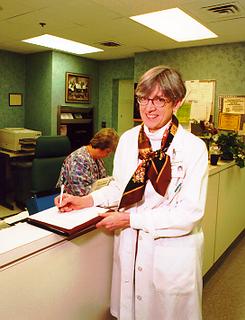Vaccine research leads fight against meningitis

Dr. Kathryn Edwards says research continues in the quest to formulate new vaccines to combat meningitis
The childhood disease meningitis has been a source of parental worry for nearly 2 centuries.
While once considered a truly dangerous childhood killer, today many cases of meningitis can be successfully prevented thanks to a vaccine for the most common bacteria that causes the disease. Vaccines are also being developed for several of the other bacteria that cause it and offer the potential to prevent the majority of cases of meningitis.
Working with researchers around the world, Vanderbilt University Medical Center physicians are at the forefront of the ongoing battle against this long-standing pediatric infectious disease.
"Many of the vaccines that now exist were studied for the first time at VUMC," said Dr. Kathryn M. Edwards, professor of Pediatrics.
That research was begun under the guidance of Dr. Sara Sell, professor emeritus of Pediatrics. Her work stimulated the development of a vaccine for Haemophilus influenzae type b (HIB), a bacterium that causes meningitis in children and leads to lasting disability.
Sell realized that by the time children were diagnosed with meningitis many already had significant problems. She believed the disease needed to be presented.
In order to gain a better understanding of the bacteria, Sell organized a gathering of 38 investigators on the cutting edge of H. influenzae research at VUMC in 1972. Stimulated by this meeting, researchers developed vaccines that were licenced in the early 1990's that virtually eliminated H. influenzae as a cause of meningitis, said Edwards.
In a 1986 study, H. influenzae was found to be the most common cause of meningitis, striking children between the ages of one month and four years old. This particular bacterium was responsible for 45 percent of meningitis cases. With the licence of the vaccine, the frequency of meningitis due to H. influenzae has declined dramatically.
"Haemophilus influenzae type b has now been pretty much eliminated because of the vaccination that we give children at two, four, and 6 months of age," said Edwards.
The discovery of this vaccine does not mean that parents or physicians can ignore the dangers of meningitis, Edwards said.
Several other bacterium cause the disease, including Streptococus pneumoniae and Neisseria meningitidis , for which there are no vaccines.
"This is not something that parents should stay awake at night worrying about, but when children have a fever or feel ill they should check with their doctor," said Edwards.
Meningitis is actually an infection of the meninges, the membrane which covers the brain and spinal cord and encases the cerebrospinal fluid. Once an infection has started, the immune system sends for inflammatory cells to come and fight the bacteria. While the inflammatory cells are fighting the infection they produce damage to the brain by releasing chemical substances that cause it to swell.
In addition, the brain can be damaged by an alteration in nutrient intake. As the inflammatory agents fight the infection, they use some of the brain's own nutrients to do so. Without these nutrients, parts of the brain can starve.
"The inflammatory cells are doing exactly what they are supposed to do, but they are also causing damage. The key to stopping this is by preventing the infection before it begins," said Edwards.
Once the infection begins, therapy consists of antibiotics such as penicillin and cefotaxime. But there are increasing concerns among doctors about strains of bacteria that are resistant to these antibiotics. In Nashville a high percentage of the S. pneumoniae isolates are resistant to penicillin. This has required the use of additional antibiotics such as vancomycin.
Doctors determine whether a patient has meningitis by examining a sample of the cerebrospinal fluid. The fluid is then cultured and examined for any trace of bacteria.
The sample may also be studied for viruses that can cause meningitis. Viral meningitis, which is usually much less severe, is more common in the summer. It cannot be treated with antibacterial agents and has to run its course.
"After a spinal tap, if bacterial meningitis is suspected physicians have to treat immediately with antibiotics to prevent long term injury. With the antibiotic therapy, the mortality rate is generally about 5-10 percent," said Edwards.
"We have been able to prevent a lot of pediatric meningitis but there are still bacteria that are causing the disease. We are looking for vaccines for both those bacteria here at VUMC," said Edwards.
Recently, research at VUMC has begun to focus on discovering a vaccine for meningitis caused by Streptoccus pheumoniae, which accounts for 18 percent of meningitis cases, and Neisseria meningitis, which is responsible for 14 percent of meningitis cases, Edwards said.
A vaccine for these two bacteria would represent a major leap in eradicating this childhood disease, Edwards said.













